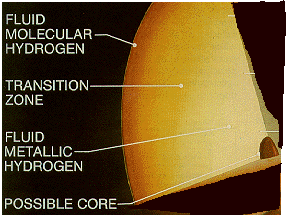This is a schematic of the interior of Saturn.
NASA
The Liquid Hydrogen Layer
The first liquid layer inside Saturn, immediately under the atmosphere, is the liquid hydrogen layer. The hydrogen atmosphere becomes thicker and thicker, a fog with more and more liquid hydrogen droplets, until the pressure of gas from regions above forces hydrogen to completely change from the gas form to the liquid form. This changes occurs at a depth of roughly 1000 km (650 miles) from the level of the first cloud deck. The hydrogen, in liquid form then behaves much as the terrestrial ocean does in forming currents and convection patterns for the purpose of carrying heat from the inside to the outside of Saturn.
Under the liquid hydrogen layer is a liquid metallic hydrogen layer. This layer also forms complicated currents and convection patterns, but because the layer is metallic, it is also able to conduct electricity. This property of the liquid metallic hydrogen layer, coupled with the stirring action of Saturn's terrifically fast spin rate (Saturn spins once in 10 hours), is what produces Saturn's enormously powerful and extensive magnetosphere.
You might also be interested in:

Motions in the interior of a planet help carry heat from the inside to the outside. The drawing to the left illustrates a kind of global motion that is typical of motions in the atmosphere as well as interior
...more
Magnetospheres are generated with 1.) magnetic materials and 2.) with motions within the magnetic material. The terrestrial planets generate magnetospheres within the iron cores at the center. This leads
...more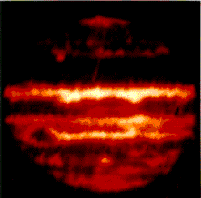
Frequently in astromony, the luminosity of a star is calculated. The luminosity indicates the energy, and the temperature of the star. When the luminosity of the outer planets was calculated, that of Jupiter
...more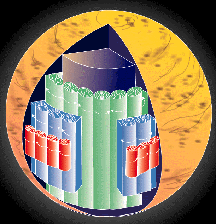
Motions, or currents in the interior of a gas-giant planet such as Saturn may be very different from the motions typical of the earth's interior. A second idea for the motions in the interior of a gas-giant
...more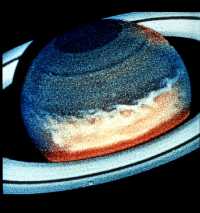
This image of Saturn makes use of false color to emphasize the cloud pattern. The clouds form in bands which move across the disk of Saturn. The banded pattern of clouds, or stripes, is similar to those
...more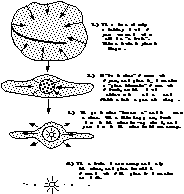
The solar system contracted out of a rotating cloud of hydrogen and helium gas. The momentum of the rotation flattened the originally round cloud into a disk, somewhat the way a ball of pizza dough can
...more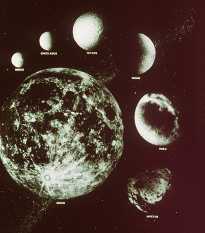
This is an image of the Earth's moon, shown in the lower left, with the six much smaller icy moons of Saturn. The moons in order, starting from the top left are: Mimas, Enceladus, Tethys, Dione, Rhea,
...more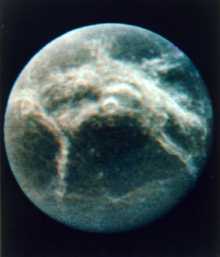
Dione was discovered by G. Cassini in 1684. Dione is the 7th farthest moon from Saturn, with a standoff distance of 377,400 km. It is a small icy moon, lightly cratered, with wispy white streaks across
...more


